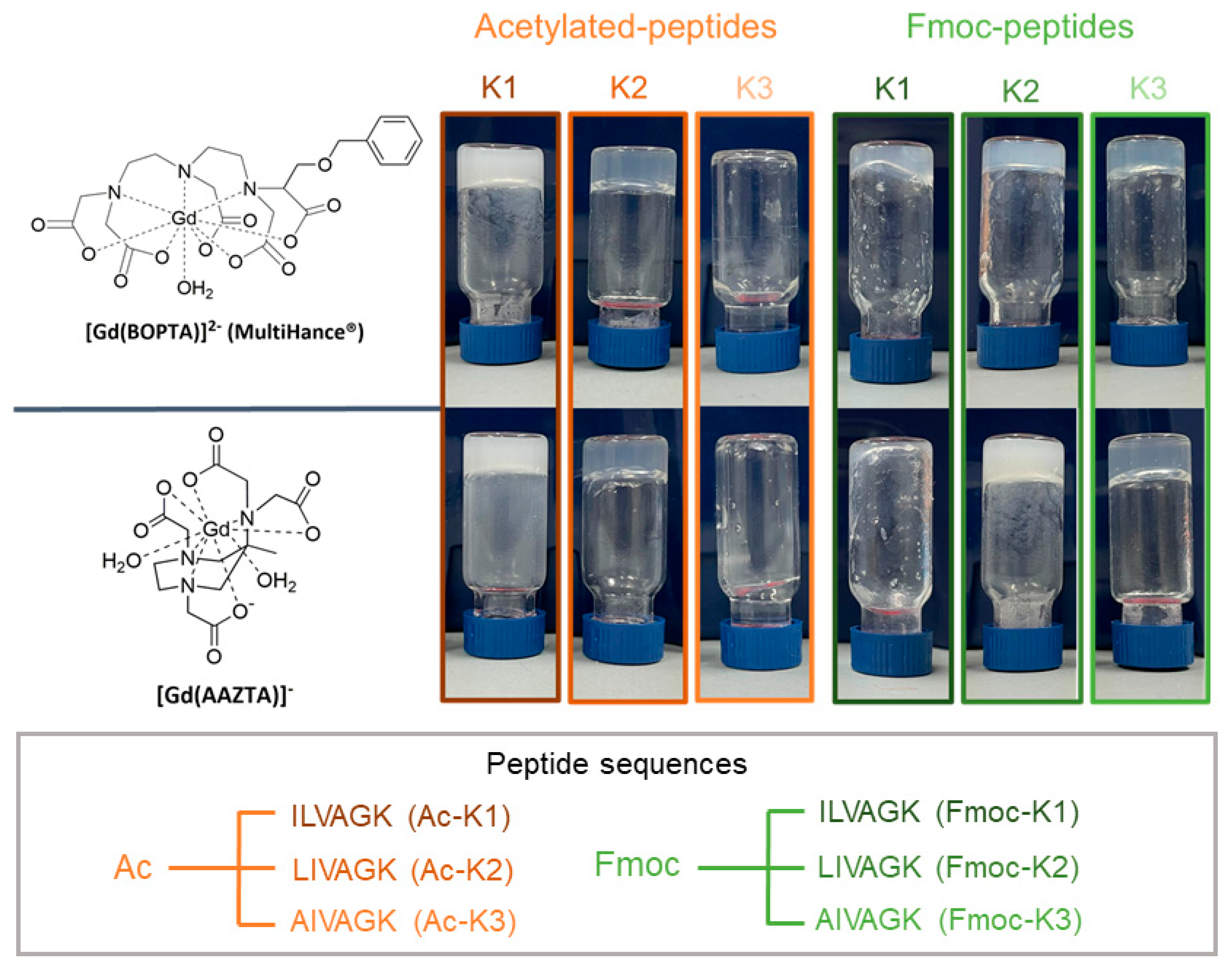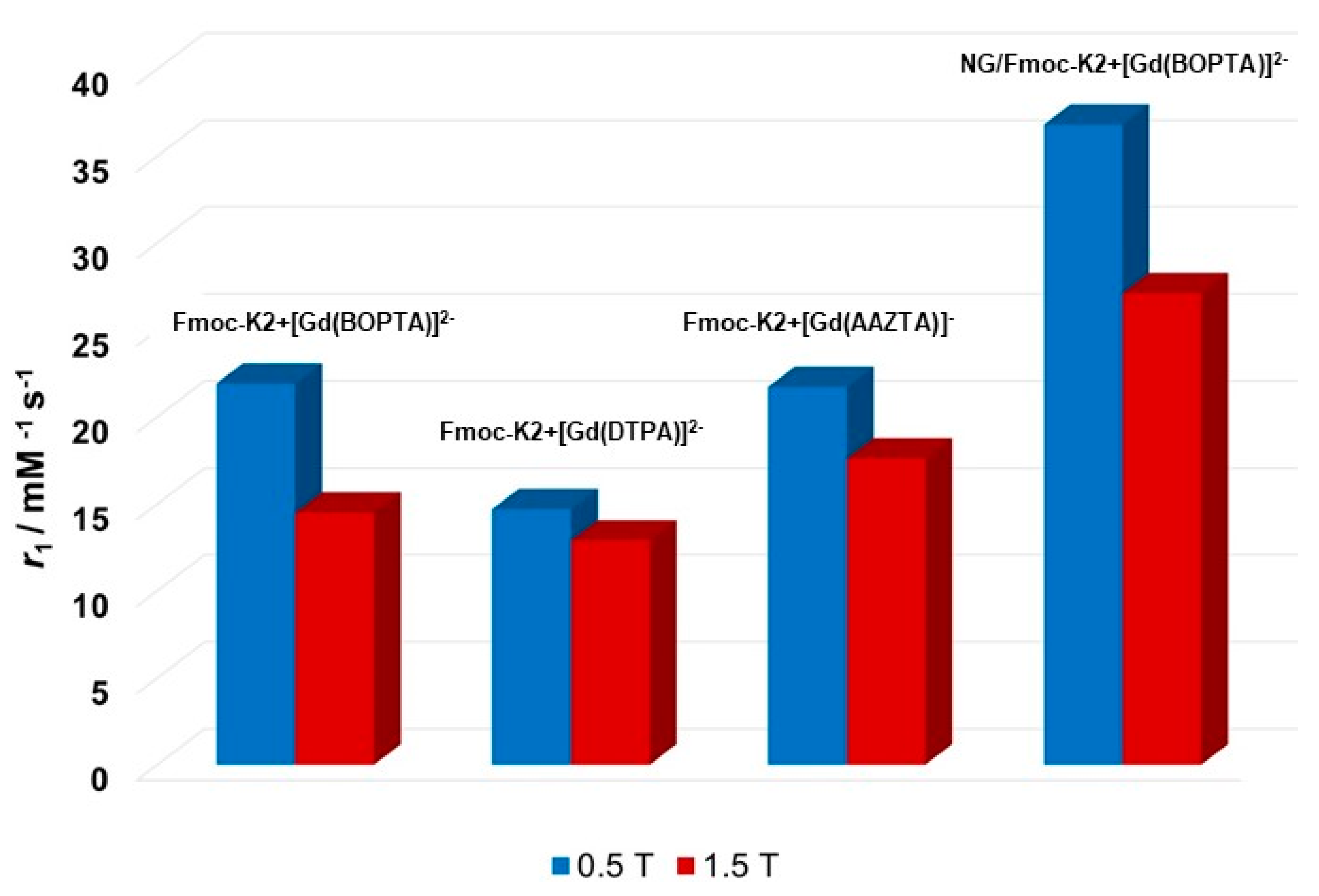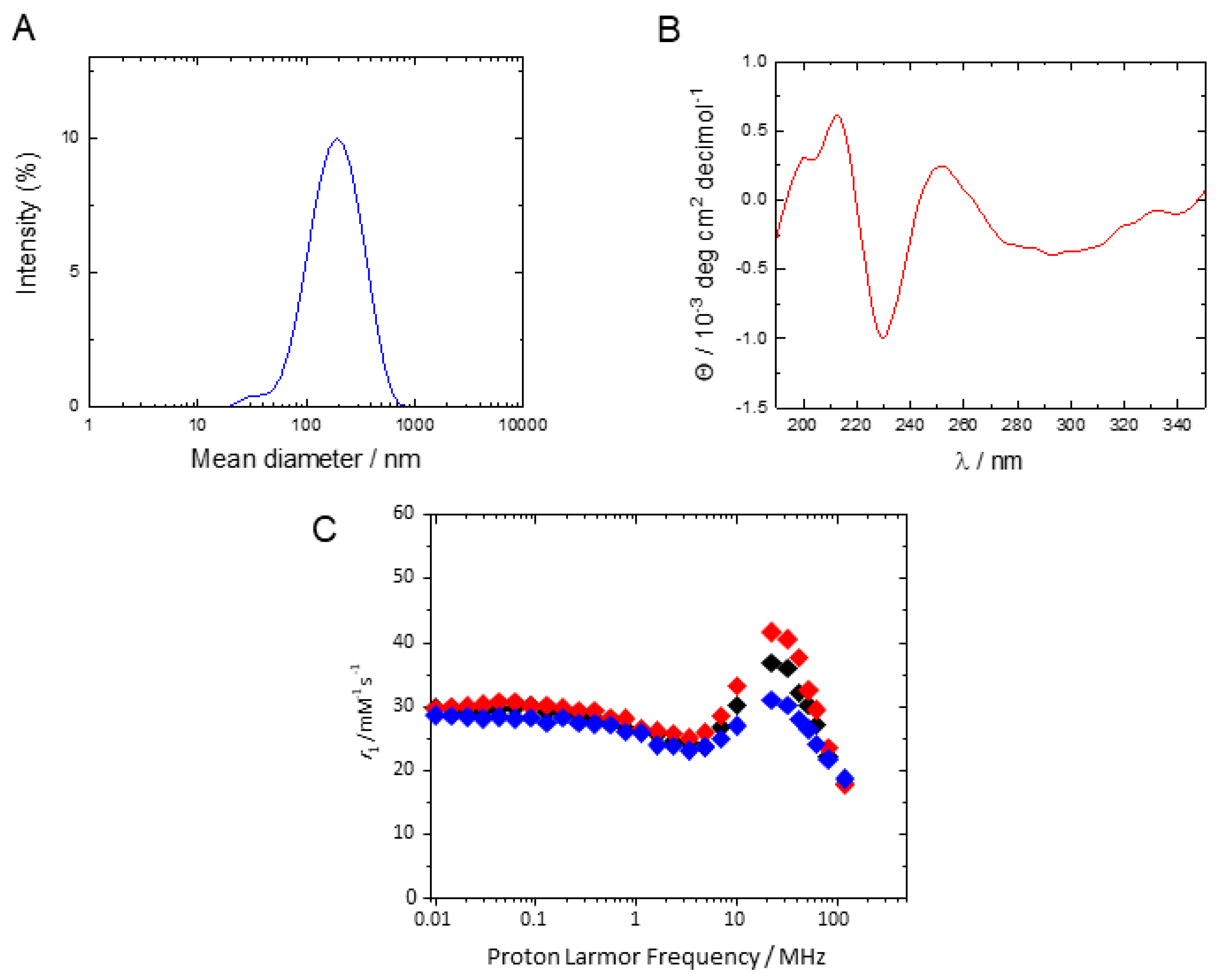Peptide-Based Hydrogels and Nanogels Containing Gd(III) Complexes as T1 Relaxation Agents
Abstract
:1. Introduction
2. Results and Discussion
2.1. Formulation and Characterization of HGs Encapsulating Gd Complexes
2.2. Structural Characterization of Hydrogels: FTIR, SEM and Rheology
2.3. Hydrogel Relaxivity Studies
2.4. Nanogel Formulation and Structural and Relaxivity Characterization
3. Materials and Methods
3.1. Peptide Solid Phase Synthesis
3.2. Preparation of Peptide Hydrogels Loaded with Gd-Complexes
3.3. Hydrogel Stability Studies
3.4. Scanning Electron Microscopy (SEM)
3.5. Fourier Transform Infrared Spectroscopy (FT-IR)
3.6. Rheological Studies
3.7. Nanogel Formulation
3.8. Dynamic Light Scattering (DLS) Measurements
3.9. Circular Dichroism (CD) Studies
3.10. Relaxometric Characterization
4. Conclusions
Supplementary Materials
Author Contributions
Funding
Data Availability Statement
Acknowledgments
Conflicts of Interest
References
- Roth-Konforti, M.E.; Comune, M.; Halperin-Sternfeld, M.; Grigoriants, I.; Shabat, D.; Adler-Abramovich, L. UV Light-Responsive Peptide-Based Supramolecular Hydrogel for Controlled Drug Delivery. Macromol. Rapid Commun. 2018, 39, e1800588. [Google Scholar] [CrossRef] [PubMed]
- Dreiss, C.A. Hydrogel design strategies for drug delivery. Curr. Opin. Colloid Interface Sci. 2020, 48, 1–17. [Google Scholar] [CrossRef]
- Dimatteo, R.; Darling, N.J.; Segura, T. In situ forming injectable hydrogels for drug delivery and wound repair. Adv. Drug Deliv. Rev. 2018, 127, 167–184. [Google Scholar] [CrossRef]
- Gallo, E.; Diaferia, C.; Rosa, E.; Smaldone, G.; Morelli, G.; Accardo, A. Peptide-Based Hydrogels and Nanogels for Delivery of Doxorubicin. Int. J. Nanomed. 2021, 16, 1617–1630. [Google Scholar] [CrossRef] [PubMed]
- Karavasili, C.; Panteris, E.; Vizirianakis, I.S.; Koutsopoulos, S.; Fatouros, D.G. Chemotherapeutic Delivery from a Self-Assembling Peptide Nanofiber Hydrogel for the Management of Glioblastoma. Pharm. Res. 2018, 35, 166. [Google Scholar] [CrossRef] [PubMed]
- Huettner, N.; Dargaville, T.R.; Forget, A. Discovering Cell-Adhesion Peptides in Tissue Engineering: Beyond RGD. Trends Biotechnol. 2018, 36, 372–383. [Google Scholar] [CrossRef] [PubMed]
- Saunders, L.; Ma, P.X. Self-Healing Supramolecular Hydrogels for Tissue Engineering Applications. Macromol. Biosci. 2019, 19, e1800313. [Google Scholar] [CrossRef] [Green Version]
- Aviv, M.; Halperin-Sternfeld, M.; Grigoriants, I.; Buzhansky, L.; Mironi-Harpaz, I.; Seliktar, D.; Einav, S.; Nevo, Z.; Adler-Abramovich, L. Improving the Mechanical Rigidity of Hyaluronic Acid by Integration of a Supramolecular Peptide Matrix. ACS Appl. Mater. Interfaces 2018, 10, 41883–41891. [Google Scholar] [CrossRef]
- Vieira, V.M.P.; Lima, A.C.; De Jong, M.; Smith, D.K. Commercially Relevant Orthogonal Multi-Component Supramolecular Hydrogels for Programmed Cell Growth. Chem. Eur. J. 2018, 24, 15112–15118. [Google Scholar] [CrossRef] [Green Version]
- Chamkouri, H.; Chamkouri, M. A Review of Hydrogels, Their Properties and Applications in Medicine. Am. J. Biomed. Sci. Res. 2021, 11, 485–493. [Google Scholar] [CrossRef]
- Berdichevski, A.; Yameen, H.S.; Dafni, H.; Neeman, M.; Seliktara, D. Using bimodal MRI/fluorescence imaging to identify host angiogenic response to implants. Proc. Natl. Acad. Sci. USA 2015, 112, 5147–5152. [Google Scholar] [CrossRef] [Green Version]
- Fragai, M.; Ravera, E.; Tedoldi, F.; Luchinat, C.; Parigi, G. Relaxivity of Gd-Based MRI Contrast Agents in Crosslinked Hyaluronic Acid as a Model for Tissues. ChemPhysChem 2019, 20, 2204–2209. [Google Scholar] [CrossRef] [PubMed]
- Diaferia, C.; Gianolio, E.; Accardo, A. Peptide-based building blocks as structural elements for supramolecular Gd-containing MRI contrast agents. J. Pept. Sci. 2019, 25, e3157. [Google Scholar] [CrossRef] [PubMed]
- Preslar, A.T.; Parigi, G.; McClendon, M.T.; Sefick, S.S.; Moyer, T.Y.; Haney, C.R.; Waters, E.A.; MacRenaris, K.W.; Luchinat, C.; Stupp, S.I.; et al. Gd(III)-Labeled Peptide Nanofibers for Reporting on Biomaterial Localization in Vivo. ACS Nano 2014, 8, 7325–7332. [Google Scholar] [CrossRef] [PubMed] [Green Version]
- Yin, Y.; Hu, B.; Yuan, X.; Cai, L.; Gao, H.; Yang, Q. Nanogel: A Versatile Nano-Delivery System for Biomedical Applications. Pharmaceutics 2020, 12, 290. [Google Scholar] [CrossRef] [PubMed] [Green Version]
- Glangchai, L.C.; Caldorera-Moore, M.; Shi, L.; Roy, K. Nanoimprint lithography based fabrication of shape-specific, enzymatically-triggered smart nanoparticles. J. Control. Release 2008, 125, 263–272. [Google Scholar] [CrossRef]
- Gheran, C.V.; Rigaux, G.; Callewaert, M.; Berquand, A.; Molinari, M.; Chuburu, F.; Voicu, S.N.; Dinischiotu, A. Biocompatibility of Gd-loaded chitosan-hyaluronic acid nanogels as contrast agents for magnetic resonance cancer imaging. Nanomaterials 2018, 8, 201. [Google Scholar] [CrossRef] [Green Version]
- Carniato, F.; Tei, L.; Botta, M.; Ravera, E.; Fragai, M.; Parigi, G.; Luchinat, C. 1H NMR Relaxometric Study of Chitosan-Based Nanogels Containing Mono- and Bis-Hydrated Gd(III) Chelates: Clues for MRI Probes of Improved Sensitivity. ACS Appl. Bio Mat. 2020, 3, 9065–9072. [Google Scholar] [CrossRef]
- Carniato, F.; Ricci, M.; Tei, L.; Garello, F.; Terreno, E.; Ravera, E.; Parigi, G.; Luchinat, C.; Botta, M. High Relaxivity with No Coordinated Waters: A Seemingly Paradoxical Behavior of [Gd(DOTP)]5- Embedded in Nanogels. Inorg. Chem. 2022, 61, 5380–5387. [Google Scholar] [CrossRef]
- Ischakov, R.; Adler-Abramovich, L.; Buzhansky, L.; Shekhter, T.; Gazit, E. Peptide-based hydrogel nanoparticles as effective drug delivery agents. Bioorg. Med. Chem. 2013, 21, 3517–3522. [Google Scholar] [CrossRef]
- Panda, J.J.; Kaul, A.; Kumar, S.; Alam, S.; Mishra, A.K.; Kundu, G.C.; Chauhan, V.S. Modified dipeptide-based nanoparticles: Vehicles for targeted tumor drug delivery. Nanomedicine 2013, 8, 1927–1942. [Google Scholar] [CrossRef] [PubMed]
- Rosa, E.; Diaferia, C.; Gallo, E.; Morelli, G.; Accardo, A. Stable Formulations of Peptide-Based Nanogels. Molecules 2020, 25, 3455. [Google Scholar] [CrossRef] [PubMed]
- Tesauro, D.; Accardo, A.; Diaferia, C.; Milano, V.; Guillon, J.; Ronga, L.; Rossi, F. Peptide-Based Drug-Delivery Systems in Biotechnological Applications: Recent Advances and Perspectives. Molecules 2019, 24, 351. [Google Scholar] [CrossRef] [PubMed] [Green Version]
- Diaferia, C.; Rosa, E.; Gallo, E.; Smaldone, G.; Stornaiuolo, M.; Morelli, G.; Accardo, A. Supporting Hydrogels Based on Fmoc-Derivatized Cationic Hexapeptides for Potential Biomedical Applications. Biomedicines 2021, 9, 678. [Google Scholar] [CrossRef]
- Loo, Y.; Lakshmanan, A.; Ni, M.; Toh, L.L.; Wang, S.; Hauser, C.A.E. Peptide Bioink: Self-Assembling Nanofibrous Scaffolds for Three-Dimensional Organotypic Cultures. Nano Lett. 2015, 15, 6919–6925. [Google Scholar] [CrossRef]
- Lalli, D.; Carniato, F.; Tei, L.; Platas-Iglesias, C.; Botta, M. Surprising Complexity of the [Gd(AAZTA)(H2O)2]- Chelate Revealed by NMR in the Frequency and Time Domains. Inorg. Chem. 2021, 61, 496–506. [Google Scholar] [CrossRef]
- Aime, S.; Calabi, L.; Cavallotti, C.; Gianolio, E.; Giovenzana, G.B.; Losi, P.; Maiocchi, A.; Palmisano, G.; Sisti, M. [Gd-AAZTA]-: A New Structural Entry for an Improved Generation of MRI Contrast Agents. Inorg. Chem. 2004, 43, 7588–7590. [Google Scholar] [CrossRef]
- Uggeri, F.; Aime, S.; Anelli, P.L.; Botta, M.; Brocchetta, M.; de Haen, C.; Ermondi, G.; Grandi, M.; Paoli, P. Novel Contrast Agents for Magnetic Resonance Imaging. Synthesis and Characterization of the Ligand BOPTA and its Ln(III) Complexes (Ln = Gd, La, Lu). X-ray Structure of Disodium (TPS-9-145337286-C-S)-[4-Carboxy-5,8,ll-tris(carboxymethyI)-l-phenyl-2-oxa5,8,ll-triazatridecan-13-oato(5-)]gadolinate(2-) in a Mixture with its Enantiomer. Inorg. Chem. 1995, 34, 633–642. [Google Scholar]
- Xiao, Y.D.; Paudel, R.; Liu, J.; Ma, C.; Zhang, Z.S.; Zhou, S.K. MRI contrast agents: Classification and application (Review). Int. J. Mol. Med. 2016, 38, 1319–1326. [Google Scholar] [CrossRef] [Green Version]
- Aime, S.; Botta, M.; Terreno, E. Gd(III)-based contrast agents for MRI. Adv. Inorg. Chem. 2005, 57, 173–237. [Google Scholar]
- Helm, L.; Morrow, J.R.; Bond, C.J.; Carniato, F.; Botta, M.; Braun, M.; Baranyai, Z.; Pujales-Paradela, R.; Regueiro-Figueroa, M.; Esteban-Gómez, D.; et al. Contrast Agents for MRI: Experimental Methods; Royal Society of Chemistry: London, UK, 2018; pp. 121–242. [Google Scholar]
- Caravan, P.; Ellison, J.J.; McMurry, T.J.; Lauffer, R.B. Gadolinium(III) Chelates as MRI Contrast Agents: Structure, Dynamics, and Applications. Chem. Rev. 1999, 99, 2293–2352. [Google Scholar] [CrossRef] [PubMed]
- Iyer, A.; Roeters, S.J.; Kogan, V.; Woutersen, S.; Claessens, M.M.A.E.; Subramaniam, V. C-Terminal Truncated α-Synuclein Fibrils Contain Strongly Twisted β-Sheets. J. Am. Chem. Soc. 2017, 139, 15392–15400. [Google Scholar] [CrossRef] [PubMed]
- Chronopoulou, L.; Margheritelli, S.; Toumia, Y.; Paradossi, G.; Bordi, F.; Sennato, S.; Palocci, C. Biosynthesis and Characterization of Cross-Linked Fmoc Peptide-Based Hydrogels for Drug Delivery Applications. Gels 2015, 1, 179–193. [Google Scholar] [CrossRef] [PubMed]






| Sample | ΔW (%) | G′ (Pa) | G″ (Pa) | Tan (δ) | |
|---|---|---|---|---|---|
| Fmoc-K1 | Fmoc-K1 | --- | 557 | 40 | 13.9 |
| Fmoc-K1 + [Gd(BOPTA)]2− | 3.74 | 11 | 2 | 5.5 | |
| Fmoc-K1 + [Gd(AAZTA)]− | - | - | - | ||
| Fmoc-K2 | Fmoc-K2 | --- | 925 | 89 | 10.4 |
| Fmoc-K2 + [Gd(BOPTA)]2− | 2.65 | 57 | 6 | 9.5 | |
| Fmoc-K2 + [Gd(AAZTA)]− | 4.91 | 500 | 102 | 4.9 | |
| Fmoc-K2 + [Gd(DTPA)]2− | --- | 36 | 3 | 12 | |
| Fmoc-K3 | Fmoc-K3 | --- | 2526 | 273 | 9.2 |
| Fmoc-K3 + [Gd(BOPTA)]2− | 1.08 | 425 | 51 | 8.3 | |
| Fmoc-K3 + [Gd(AAZTA)]− | 0.01 | 4210 | 508 | 8.3 | |
| Ac-K1 | Ac-K1 | --- | 306 | 40 | 7.6 |
| Ac-K1 + [Gd(BOPTA)]2− | 0.20 | 18,280 | 3826 | 4.8 | |
| Ac-K1 + [Gd(AAZTA)]− | 0.67 | 42,583 | 5182 | 8.2 | |
| Ac-K2 | Ac-K2 | --- | 2677 | 192 | 13.9 |
| Ac-K2 + [Gd(BOPTA)]2− | 7.79 | 520 | 102 | 5.1 | |
| Ac-K2 + [Gd(AAZTA)]− | 2.81 | 11,018 | 2304 | 4.8 |
Publisher’s Note: MDPI stays neutral with regard to jurisdictional claims in published maps and institutional affiliations. |
© 2022 by the authors. Licensee MDPI, Basel, Switzerland. This article is an open access article distributed under the terms and conditions of the Creative Commons Attribution (CC BY) license (https://creativecommons.org/licenses/by/4.0/).
Share and Cite
Rosa, E.; Carniato, F.; Tei, L.; Diaferia, C.; Morelli, G.; Botta, M.; Accardo, A. Peptide-Based Hydrogels and Nanogels Containing Gd(III) Complexes as T1 Relaxation Agents. Pharmaceuticals 2022, 15, 1572. https://doi.org/10.3390/ph15121572
Rosa E, Carniato F, Tei L, Diaferia C, Morelli G, Botta M, Accardo A. Peptide-Based Hydrogels and Nanogels Containing Gd(III) Complexes as T1 Relaxation Agents. Pharmaceuticals. 2022; 15(12):1572. https://doi.org/10.3390/ph15121572
Chicago/Turabian StyleRosa, Elisabetta, Fabio Carniato, Lorenzo Tei, Carlo Diaferia, Giancarlo Morelli, Mauro Botta, and Antonella Accardo. 2022. "Peptide-Based Hydrogels and Nanogels Containing Gd(III) Complexes as T1 Relaxation Agents" Pharmaceuticals 15, no. 12: 1572. https://doi.org/10.3390/ph15121572
APA StyleRosa, E., Carniato, F., Tei, L., Diaferia, C., Morelli, G., Botta, M., & Accardo, A. (2022). Peptide-Based Hydrogels and Nanogels Containing Gd(III) Complexes as T1 Relaxation Agents. Pharmaceuticals, 15(12), 1572. https://doi.org/10.3390/ph15121572










